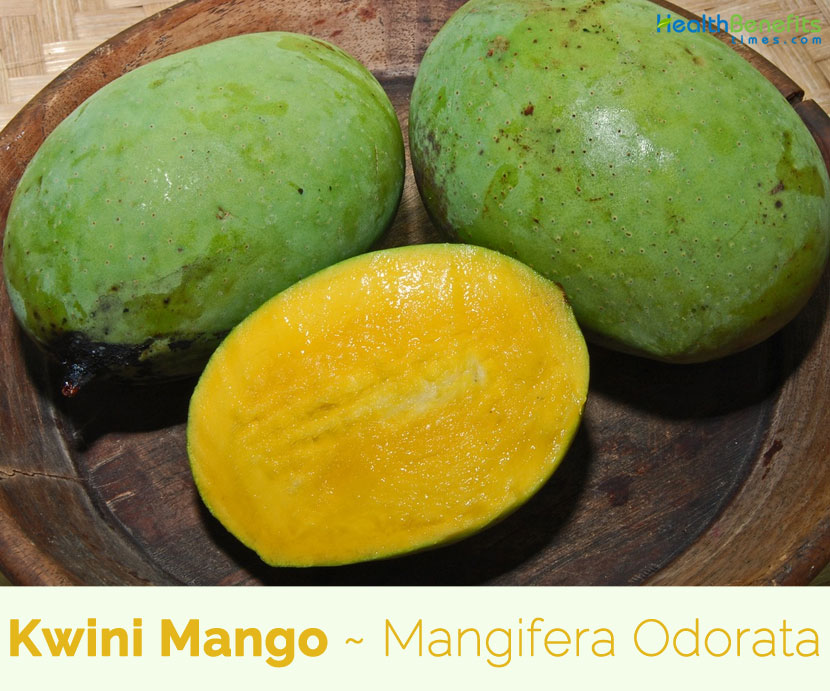| Kwini Mango Quick Facts | |
|---|---|
| Name: | Kwini Mango |
| Scientific Name: | Mangifera Odorata |
| Origin | Tropical Asia, specifically to West Malaysia |
| Colors | Green to yellowish-green, sparingly spotted with dark brown lenticels |
| Shapes | Obliquely ellipsoid-oblong, hardly flattened drupe, 10-13 cm long and 6-9 cm in diameter, fragrant |
| Flesh colors | Orange-yellow |
| Taste | Mild taste of turpentine |
Few of the well-known names of the plant are Fragrant Mango, Kuini, Kurwini Mango, Kwini, Kwini Mango, Kuweni, Wani, Kuwini mango, saipan mango, manga manila, manga wani, palipisan, kweni, huani, kuwini, bembem, kaweni, kuweni, uani, juani, kinning, mamuang paa, cay muong and binjai. The name of the genus comes from the combination of one local name of its fruits, manga, with the Latin verb fero which means I carry. The Latin name of the species, odorata means fragrant, refers to the intense odor discharged by the flowers.
Plant Description
Kwini Mango is a medium-sized, evergreen tree that grows about 10–30 m, rarely more than 30 m high with a round or broadly ovoid canopy, straight trunk with grey, smooth or fissured bark, containing caustic sap. The plant grows well in any well drained slightly acidic soil. Leaves are irregularly scattered on rather thick branchlets, oblong-lance-shaped, measuring 12-35 cm long and 4-10 cm wide, coriaceous-chartaceous, with non-wavy edge, shortly acuminate, with prominent reticulated veins especially on the lower surface and not or hardly odorous when bruised. The petiole is 3-7cm and swollen at base.
Flower
The panicles are terminal, pyramidal, 15-50 cm long, rather densely flowered and yellowish-green tinged with reddish-brown rachis. Flowers are 5(-6)-merous, about 6 mm wide and fragrant. Sepals are ovate, 3-4 mm long and brown-red or partly green. Petals are lance-shaped, measuring about 5-6 mm x 1.2-2 mm, yellowish at the base, pale pinkish towards the apex, reflexed, with 3-5 fingers (ridges) on 2/3 of the length of the petals, confluent at the base and pale yellow but later turn to dark red. There are 5(-6) stamens, with only 1 fertile while the filament is 5 mm long and staminodes are 1.5-2 mm long. The ovary is nearly spherical, yellowish, with excentric style, 3-5 mm long and dark red.
Fruit
Fertile flowers are followed an obliquely ellipsoid-oblong, hardly flattened drupe, measuring 10-13 cm long and 6-9 cm wide. Fruits are initially green turning to yellowish-green and sparingly spotted with dark brown lenticels as they mature. The rind is rather thick about 3-4 mm. The flesh is orange-yellow, firm, fibrous, sourish-sweet, juicy, with a pungent smell and taste of turpentine while its stone measures 8-10 cm x 4.5-5 cm x 2.5-3 cm and covered with soft fibers.
Traditional uses and benefits of Kwini Mango
- In folk medicine, the bark is recommended for external application in hystero-epilepsy, in the form of a compound like a cosmetic mixture.
- Sap from the tree and unripe fruit is caustic and has been reported to cause dermatitis.
- Regular consumption of mangoes by pregnant women ensures the proper development of the fetus.
- It contains phenolic compounds, which are rich in anti-oxidants, which help in fighting cancer.
- If consumed on a regular basis, mangoes help to combat acidity and ensure proper bowel movement, thereby making the digestive system strong.
- It is a is a rich source of vitamin A, E and Selenium, which help to protect against heart disease and other such related ailments.
- It is also an effective remedy to remove clogged pores of the skin.
- Research has shown that eating mangoes can help you get relief from Kidney related problems including nephritis.
- Eating mangoes also provides relief from respiratory problems, fever, constipation, etc.
Culinary uses
- The pulp of the ripe fruit is eaten raw.
- Ripe and unripe fruit are also eaten as rujak.
- They must be peeled thick because of the presence of an acrid juice in the skin, which can also be reduced by steeping in diluted lime-water before eating.
- Unripe fruit is also used for making chutney and for pickles with salt and also used in curries.
- Seeds are used for making a kind of flour for preparing the traditional delicacy jenang pelok or dodol in Java.
- Fruit is sometimes eaten unripe in salads or added to smoothies.
- Fruits are also used for making chutney and for pickles with salt.
Other Facts
- The wood is used locally as bachang (M. foetida), but is reportedly of poor quality.
- Kuwini can produce two crops a year in areas where two dry seasons prevail.
- Heartwood is light brown or light grey brown, occasionally with chocolate or black streaky coreword; it is not clearly differentiated from the wide band of sapwood.
- Wood is moderately heavy to heavy, moderately hard, not durable under exposed conditions, being susceptible to fungi, dry wood borers and termites.
- Wood is suitable for light construction, turnery, flooring, interior paneling, boxes, crates, pallets and plywood manufacture.
- Corewood can be used for decorative veneer production.
References:
https://www.itis.gov/servlet/SingleRpt/SingleRpt?search_topic=TSN&search_value=506474#null
https://npgsweb.ars-grin.gov/gringlobal/taxonomydetail.aspx?id=23354
https://plants.usda.gov/core/profile?symbol=MAOD
http://www.theplantlist.org/tpl1.1/record/kew-2362639
https://uses.plantnet-project.org/en/Mangifera_odorata_(PROSEA)
https://florafaunaweb.nparks.gov.sg/special-pages/plant-detail.aspx?id=5626
http://tropical.theferns.info/viewtropical.php?id=Mangifera+odorata
https://gd.eppo.int/taxon/MNGOD
https://en.wikipedia.org/wiki/Mangifera_odorata
http://www.worldagroforestry.org/treedb/AFTPDFS/Mangifera_odorata.PDF
https://www.cabi.org/isc/datasheet/34510
Comments
comments
